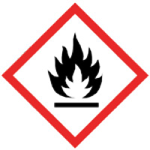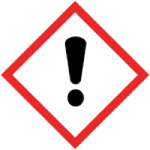Toothbrush Cleaner MSDS
Downloadable Toothbrush Cleaner MSDS coming soon.
Section 1: Identification
Product Identifier: Toothbrush Cleaner
Manufacturer Information:
Vermont Soap
616 Exchange Street
Middlebury, VT 05753
1(866)SOAP-4U2
Emergency Number: 802-388-4302
Recommended use of the chemical: Alcohol. Used to clean toothbrushes and other oral care items.
Section 2: Hazard Identification
Hazard Classification: Non-hazardous
Signal word: DANGER!
Hazard Statement: Highly flammable liquid and vapor. Causes skin and eye irritation. May cause respiratory irritation.



Precautionary statements:
Dispose of contents and container to an approved waste disposal plant. Ground/bond container and receiving equipment. If eye irritation persists: get medical attention, IF IN EYES: Remove contact lenses, Thoroughly flush the eyes with large amounts of clean low pressure water or milk for at least 15 minutes, occasionally lifting the upper and lower eyelids. If irritation persists, get medical attention. IF ON SKIN: Immediately flush affected area with plenty of water while removing contaminated clothing. Wash contaminated clothing before reuse. Contact a doctor. If irritation persists, get medical attention. In case of fire use dry chemicals, CO2, water spray or alcohol-resistant foam. Keep away from sparks, open flame, and hot surfaces. NO SMOKING. Keep Container lid tightly closed. Store in a well-ventilated place. Keep Cool. Take precautionary measures against static discharge. Use explosion-proof electrical, ventilating and lighting equipment. Use only non-sparking tools. Wash hands thoroughly after handling. Wear protective gloves and eye and face protection.
Description of any hazards not otherwise classified :
- Eyes: Causes irritation to the eyes. Can cause painful sensitization to light. Can cause a form of chemical conjunctivitis and cause corneal damage
- Ingestion: Can cause gastrointestinal irritation with nausea, vomiting and diarrhea. Systemic toxicity and acidosis can occur. Advanced stages can lead to respiratory failure, kidney failure, coma, and death.
- Inhalation Causes respiratory tract irritation. Can cause narcotic effects in high concentration. Vapors may cause dizziness or suffocation. Systemic toxicity and acidosis can occur. Advanced stages can lead to respiratory failure, kidney failure, coma, and death.
- Skin: Causes moderate skin irritation. Can cause dermatitis by de-fatting the skin from prolonged or repeated contact.
Section 3: Composition/Information on Ingredients
Substances
- Chemical name: Denatured Alcohol SDA 38b017, 190 PROOF
- Common name and synonyms: Denatured Alcohol, Ethanol Denatured with Peppermint, Toothbrush Cleaner
- Chemical Abstracts Service (CAS) number: Ethyl Alcohol – 64-17-5, Peppermint oil-8006-90-4, Water-7732-18-5, Eucalyptus oil – 8000-48-4
- Impurities and stabilizing additives, which are themselves classified and which contribute to the classification of the chemical Not Applicable
- Chemicals are a trade secret
Contents are as read on the label. Exact percentages are a trade secret
Ingredients: Certified organic alcohol denatured with organic peppermint essential oil (70%), organic eucalyptus oil
Section 4: First Aid Measures
- Skin: Immediately flush affected area with plenty of water while removing contaminated clothing. Wash contaminated clothing before reuse. Contact a doctor. If irritation persists, get medical attention.
- Inhalation: Remove to fresh air. If signs/symptoms continue, get medical attention. Give oxygen or respiration as needed.
- Eyes: Thoroughly flush the eyes with large amounts of clean low pressure water for at least 15 minutes, occasionally lifting the upper and lower eyelids. If irritation persists, get medical attention.
- Ingestion: DO NOT induce vomiting. If vomiting does occur, have victim lean forward to prevent aspiration. Rinse mouth with water. Seek medical attention. Never give anything by mouth to an unconscious individual.
Section 5 : Firefighting Measures
Flammability Classification: OSHA/NFPA Class IB Flammable Liquid
Flash Point (F): 17C (62F)
Extinguishing Medium: SMALL Fire use dry chemicals, CO2, water spray or alcohol-resistant foam. LARGE FIRE Use water spray, water fog or alcohol-resistant foam. Cool all affected containers with flooding quantities of water.
Unusual Fire and Explosion Hazards: May produce a floating fire hazard. Static ignition hazard can result from handling and use.
Hazards arising from chemical: Carbon oxides expected to be the primary hazardous combustion product.
Special Protective equipment and precautions for firefighters: Wear self-contained breathing apparatus and protective clothing to prevent contact with skin and eyes. Keep unopened containers cool by spraying with water.
Section 6: Accidental Release Measures
Personal Precautions/Emergency procedures:
DO NOT inhale vapors, mist or gas. Ensure adequate ventilation. Remove all sources of ignition. Evacuate personnel to safe areas. Beware of vapors accumulation to form explosive concentrations. Vapors can accumulate in low areas.
Methods and materials used for containment :
Highly flammable liquid. Eliminate all sources of ignition. All equipment used when handling this product must be grounded. A vapor suppressing foam may be used to reduce vapors. Do not touch or walk through spilled material. Contain spillage, and then collect with non-combustible absorbent material, (e.g. sand, earth diatomaceous earth, vermiculite) and place in container for disposal according to local/national regulations. Use clean non-sparking tools to collect absorbed material.
Section 7: Handling and Storage
Precautions for safe handling:
Do not get on skin or eyes. DO NOT inhale vapor or mist. Keep away from sources of ignition. No Smoking. Take measures to prevent the buildup of electrostatic charge. Open and handle container with care. Metal containers involved in the transfer of this material should be grounded or bonded.
Safe storage, including any incompatibilities:
Keep container tightly closed in a cool, dry and well ventilated place. Containers which are opened must be carefully resealed and kept upright to prevent leakage. Consult local fire codes for additional storage information.
Section 8: Exposure Controls/ Personal Protection
Occupational Exposure Limits
Component, Source, Type, Value, Note
Ethyl Alcohol, US (OSHA), IDHL, 3300ppm, None
Ethyl Alcohol, US (acgih), STEL, 1000ppm, Upper Respiratory Tract irritation. Confirmed animal carcinogen with unknown relevance to humans
Ethyl Alcohol, US (OSHA), TWA, 100ppm/1900mg/m3, 29 CFR 1910.1000 Table z-1 limits for air Contaminants
Peppermint Oil
Water
Section 9: Physical and Chemical Properties
Appearance (physical state, color, etc.) Liquid. Colorless liquid / invisible vapor.
Odor Peppermint mixed with alcohol
Odor threshold Specific data not available
pH Specific data not available
Freezing point -114 °C (-173 °F)
Initial boiling point and boiling range 80°C (176°F) (for 100% ethanol)
Flash point 17 °C (63°F) – closed cup
Evaporation rate Specific data not available – expected to be rapid.
Flammability (solid, gas) Flammable
Upper / Lower flammability or explosive limits 19%(V) / 3.3% (V) (for 100% ethanol)
Vapor pressure 59.5 hPa (44.6 mmHg) at 20 °C (68 °F) (for 100% ethanol)
Vapor Density 1.6
Relative Density 0.816 g/mL at 25 °C (77 °F)
Solubility(ies) Miscible
Partition coefficient n-octanol/water(ies) Specific data not available
Auto-ignition temperature 363 °C (685 °F) (for 100% ethanol)
Decomposition temperature Specific data not available
Formula (ETHANOL) C2H6O
Formula (WATER) H2O
Molecular Weight (ETHANOL) 46.07 g/mol
Molecular Weight (WATER) 18.02 g/mol
Section 10: Stability and Reactivity
Chemical Stability Stable under recommended storage conditions.
Possibility of hazardous reactions Vapors may form explosive mixture with air.
Conditions to avoid (e.g., static discharge, shock or vibration) Heat, flames, and sparks. Extreme temperatures and direct sunlight.
Incompatible materials Alkali metals, Ammonia, Oxidizing agents, Peroxides, Strong Inorganic Acids
Hazardous decomposition products Carbon oxides are expected to be, under fire conditions, the primary hazardous decomposition products.
Section 11: Toxicological Information
Ethyl Alcohol 64-17-5
Signs and Symptoms of Exposure
Central nervous system depression, narcosis, damage to the heart. To the best of our knowledge, the chemical, physical, and toxicological properties have not been thoroughly investigated.
Product Summary:
Ethanol is not toxic by OSHA standards. Coingestion of sedative hypnotics or tranquilizers can increase the toxic affects of ethanol. No data available to designate the product as causing specific target organ toxicity through repeated exposure. No data available to designate product as an aspiration hazard.
Acute Toxicity:
LC50 Inhalation Rat 20000 ppm 10 hrs.
LC50 Oral Rat 7060mg/Kg BWT
LDLo Oral Human 1400 mg/Kg BWT
Irritation:
Eyes (ETHANOL)
Eye exposure to Ethanol generally causes transient pain, irritation, and reflex lid closure. A foreign-body sensation may persist for one to two days. Vapors produce transient stinging and tearing, but no apparent adverse effects. Transiently impaired perception of color may occur with acute ingestion or chronic alcoholism.
Standard Draize eye test (rabbit) – Dose: 500 mg Reaction: Severe Dose: 500 mg/24 hrs Reaction: Mild
Other Hazards
- Eyes: Causes irritation to the eyes. Can cause painful sensitization to light. Can cause a form of chemical conjunctivitis and cause corneal damage.
- Ingestion: Can cause gastrointestinal irritation with nausea, vomiting and diarrhea. Systemic toxicity and acidosis can occur. Advanced stages can lead to respiratory failure, kidney failure, coma, and death.
- Inhalation: Causes respiratory tract irritation. Can cause narcotic effects in high concentration. Vapors may cause dizziness or suffocation. Systemic toxicity and acidosis can occur. Advanced stages can lead to respiratory failure, kidney failure, coma, and death.
- Skin: Causes moderate skin irritation. Can cause dermatitis by de-fatting the skin from prolonged or repeated contact.
- Chronic Prolonged exposure can cause liver, kidney, and heart damage. Long term exposure can cause loss of appetite, weight loss, nervousness, memory loss, mental retardation.
l Water 7732-18-5
Product Summary:
No data available for the teratogenic, mutagenic, or reproductive toxicity effects of this product. No data available to designate the product as causing specific target organ toxicity through single or repeated exposure. No data available to designate product as an aspiration hazard or as a respiratory or skin sensitizer.
Acute Toxicity:
No data available Oral LD50 Dermal LD50 Inhalation LC50
Irritation:
Eyes
No data available.
Skin
No data available
Carcinogenicity
IARC: No component of this product present at levels greater than or equal to 0.1% is identified as probable or confirmed human carcinogen by IARC.
ACGIH: No component of this product present at levels greater than or equal to 0.1% is identified as a carcinogen or potential carcinogen by ACGIH.
NTP: No component of this product present at levels greater than or equal to 0.1% is identified as a known or anticipated carcinogen by NTP.
OSHA: No component of this product present at levels greater than or equal to 0.1% is identified as a carcinogen or potential carcinogen by OSHA.
Other Hazards
Organ Description
Eyes No known hazards.
Ingestion No known hazards.
Inhalation Can be harmful if inhaled. Can cause irritation to upper respiratory tract.
Skin No known hazards.
Section 12: Ecological Information
Ethyl Alcohol 64-17-5
Ecotoxicity (aquatic and terrestrial, where available):
Acute Fish toxicity (ETHANOL)
LC50 / 96 HOUR Oncorhynchus mykiss (rainbow trout) > 10,000 mg/l
LC50 / 96 HOUR Pimephales promelas (fathead minnow) > 13,400 mg/l
Toxicity to aquatic plants (ETHANOL)
Growth inhibition / 96 HOURS Chlorella vulgaris (Fresh water algae) 1,000 mg/l
Toxicity to microorganisms (ETHANOL)
Toxicity Threshold / Pseudomonas putida 6,500 mg/l
Summary: Inhibition of cell multiplication begins.
Persistence and degradability:
Biodegradation is expected.
Bioaccumulative potential:
Biaccumulation is unlikely
Other adverse effects:
No data available
Water 7732-18-5
Ecotoxicity (aquatic and terrestrial, where available):
Ecotoxicity
Not Applicable
Persistence and degradability:
No data available
Bioaccumulative potential:
No data available
Other adverse effects:
No data available
Section 13 Disposal Considerations
Description of waste residues and information on their safe handling and methods of disposal, including the disposal of any contaminated packaging:
Burn in a chemical incinerator equipped with an afterburner and scrubber but exert extra care in igniting as this material is highly flammable. Observe all federal, state, and local environmental regulations. Contact a licensed professional waste disposal service to dispose of this material.
Section 14: Transport Information
UN number: 1170 Class: 3 Packing Group : II
EMS Number: F-E, S-D
UN proper shipping name: Ethanol Solutions
Transport hazard class(es): 3
Packing group number: II
Environmental hazards (e.g., identify whether it is a marine pollutant according to the International Maritime Dangerous Goods Code (IMDG Code)) No
Section 15: Regulatory Information
Safety, health and environmental regulations specific for the product in question:
OSHA Hazards
Flammable liquid, Target Organ Effect, Irritant
All ingredients are on the following inventories or are exempted from listing
Country Notification
Australia AICS
Canada DSL
China IECS
European Union EINECS
Japan ENCS/ISHL
Korea ECL
New Zealand NZIoC
Philippines PICCS
United States of America TSCA
SARA 302 Components
No chemicals in this material are subject to the reporting requirements of SARA Title III, Section 302.
SARA 313 Components
This material does not contain any chemical components with known CAS numbers that exceed the threshold (De
Minimis) reporting levels established by SARA Title III, Section 313.
SARA 311/312 Hazards
Acute Health Hazard
Chronic Health Hazard
Fire Hazard
CERCLA
No chemicals in this material with known CAS numbers are subject to the reporting requirements of CERCLA
Massachusetts Right To Know Components
Ethanol CAS-No.64-17-5 Revision Date 2007-03-01
Pennsylvania Right To Know Components
Ethanol CAS-No.64-17-5 Revision Date 2007-03-01
New Jersey Right To Know Components
Ethanol CAS-No.64-17-5 Revision Date 2007-03-01
California Prop 65 Components
WARNING! This product contains a chemical known to the State of California to cause birth defects or other
reproductive harm (ETHYL ALCOHOL) CAS No. 64-17-5
Section 16: Other Information
Last Revision :1/14/15